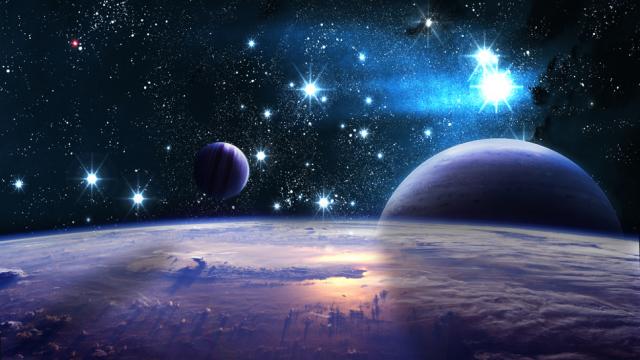Our universe appears to be bound by a finite set of laws, yet we often talk about things that go on for an eternity. “Infinity” is a strange idea. But it’s crucial if you want to understand anything from philosophy to mathematics. Here’s why.
There are three broad domains where infinity can be applied. It’s used as a conceptual tool to help us describe the properties and values of objects and processes, it’s an important notion in philosophy, cosmology and metaphysics, and, of course, it’s crucial to mathematics. Let’s take a look at each of these in detail.
The Totality of Infinity
We often use the word ‘infinity’ when describing something that goes on forever. But it can also be used to describe something that doesn’t go on forever, or for which its value is absolute.
Take, for example, the use of infinity in sports and gaming. As every chess player knows, each piece is assigned a numerical value according to its tactical importance and strength. These values range from one (pawns) to nine (the queen), and are often used to keep a kind of score as the game progresses. But the king is assigned infinite value — and for very good reason. Losing the king is fatal. It’s instant game over, regardless of whatever else might be happening in the match. The king’s worth, therefore, cannot be bound within a finite set of values.

Image: Shutterstock/18percentgrey.
Similarly, an overtime goal in hockey, or a ‘golden goal’ in soccer, can likewise be ascribed infinite value. Any situation in which a single goal causes the match to come to an immediate end, and along with it both instant victory and defeat, hinges on an absolutist event.
More importantly, philosophers, religious scholars, legal experts, and ethicists often assign an infinite value to human life. And indeed, as an enlightened society, we’re appalled by the idea of attaching a price to such a thing. We simply cannot buy, sell, or trade each other. Of course, this doesn’t always work in practice. During war, human lives are sacrificed to protect the larger body of citizens and to uphold certain values and institutions. And illicit human trafficking is an ongoing problem. But at a conceptual level, and as many religious thinkers argue (especially Christians), there is no price high enough to allow for the ‘buying’ of human life, and there’s no situation grave enough to warrant killing (i.e. Thou shalt not kill); only God has the power — and the right — to take away the gift of life.
And therein lies another kind of infinity: death. Assuming that nothing awaits us in the afterlife, the termination of our lives represents a kind of eternity. It’s an eternity of nothingness, but an eternity nonetheless.
Infinite In All Directions
But while infinity can be used as a helpful conceptual tool, it’s also something that may be physically, tangibly real — especially when considering some of the freakier aspects of philosophy, cosmology and metaphysics.
Take for example the eerie findings of string theory. Though controversial, the theory suggests the presence of 10 or 11 spacetime dimensions. The extra six or seven dimensions could be compacted at an insanely small scale, or our universe could be located on a D-brane — a dynamic (3+1)-dimensional object. Columbia University physicist Brian Greene argues that these branes could support parallel universe, giving rise to the multiverse hypothesis and the potential for an infinite set of braneworlds; these worlds aren’t always parallel and out of reach, resulting in constant collisions that cause an infinite succession of Big Bangs.
But there are other examples as well. Cosmologist Lee Smolin, in his book The Life of the Cosmos, proposed that universes are nothing more than black hole generators. According to his theory of cosmological natural selection, each black hole spawns a daughter universe. The process is then repeated — likely for an infinity.
And indeed, we’re not certain if the universe (or multiverse) has an end — or a beginning for that matter. Perhaps it’s always been here and it always will.
We’re also not sure about the shape of space-time. If it’s flat, then it could stretch out for an infinity — but it must start repeating at some point owing to the finite number of ways particles can be arranged in space and time. If this is the case, then there are an infinite number of universes.
Quantum mechanics also suggests an infinite universe. Everett’s Many Worlds Interpretation (MWI) states that the universe branches off into distinct worlds to accommodate every single possible outcome. We may live in an infinite web of alternate timelines.
This raises some interesting — if not deeply troubling — issues.
If the MWI is true, for example, every possible outcome that can be observed will be observed — no matter how ludicrous or extreme.
And given an infinite amount of time, freak disembodied minds, called Boltzman Brains, could eventually pop into existence owing to the right configurations of matter and energy. Thankfully, a new interpretation of string theory suggests that humanity will never be overrun by these spontaneously forming disembodied space brains.
The Maths of the Matter
Lastly, Image: Rasmus Holmboe Dahl/Shutterstock.
In set theory, this would include a group like {1,2,3,4} and {banana, cake, fork, napkin) — a set with a cardinality of 4 (i.e. the size of a set). Some of these countable sets are infinite (called enumerable infinities), like the set of all integers (yes, members of a countably infinite set can be counted, even though it would take an infinity to do so). But because a single number cannot describe the size of an infinite set, Cantor used the term aleph-0, or aleph-null (aleph being the first letter of the Hebrew alphabet) to signify the cardinality of an infinite set.
Indeed, aleph-0 is a cardinal number despite the fact that infinity should not be considered a number; but numeration can in fact be extended to infinite quantities so long as consistent definitions are maintained. Needless to say, infinite cardinal numbers don’t follow the same mathematical rules as finite number — you can’t just throw them into an equation and hope for the best.
Aleph-0 can include such sets as the set of all prime numbers, all rational numbers, all algebraic numbers, the set of binary strings of all finite lengths, and the set of all finite subsets of any countably infinite set.
Interestingly, the number 2 is a countable infinity. It’s a number that can be physically realised, but it consists of an infinite number of fractions.
Uncountable infinities, on the other hand, happens when you get into irrational numbers, like the square root of 2, or transcendental numbers like pi and e. The reason why these sets are considered uncountable is because they cannot be numbered.
Cantor proved this by offering a thought experiment. If we had a numbering scheme that was supposed to count all the real numbers, we could go down that list, and for the nth term, read off the nth digit. But we could then change it to something different and use it on our new number. But since this “newly constructed number” is different from every other number on the list (at the nth digit at the very least), then it must have been missed in the enumeration. The list cannot be enumerated in any way. It’s simply too big, and thus uncountable.
Numbering Nonsense
As an aside, number systems cannot accommodate the concept of infinity. No “infinity” concept exists in the context of any number system, if by number system we mean any collection of concepts that have operations like addition and multiplication — operations which obey the usual properties of arithmetic.
For example, what would infinity minus 1 be? It couldn’t be a finite number, since no finite number plus 1 equals infinity. This would violate the rules of arithmetic, leading to such absurd equations like -1=0, which isn’t true. So infinity doesn’t exist, if by “exist” we’re talking about the context of a number system.
Topological Spaces
Topological spaces describe the properties of surfaces outside of angles and distances. So, if two surfaces can be mapped together (i.e. made the same) by stretching and pulling them, rather than cutting and pasting them, they’re considered identical from a topological perspective.
Interestingly, the real number system is considered a topological space. We can come up with a definition of what it means for a sequences of numbers, rather than surfaces, to converge. For example, the sequence {1.1, 1.01, 1.001, 1.0001…} converges to the number 1, while the sequence {1, 2, 1, 2, 1, 2, 1, 2…} doesn’t converge to anything.
In calculus, it’s said that sequences like {1,2,3,4…} converge to infinity. But can it truly be said that there’s an actual object called “infinity” that this sequence can be converged to? Is there some topological space — i.e. a set of objects plus a definition of what convergence means — that includes real numbers and also an infinity concept to which some sequences of real numbers converge?
Perhaps surprisingly, the answer is yes.
Ask a Mathematician provides an explanation:
When topologists work with the real number line (i.e. the set of real numbers together with the usual notion of distance which induces topological structure), they sometimes introduce a “point at infinity”. This point, denoted infty can be thought of as the point that you would always be heading towards if you started at 0 and travelled in either direction at any speed for as long as you liked. Strangely, when this infinite point is added to the real number line, it makes it topologically equivalent to a circle (think about the two ends of the number line both joining up to this single infinite point, which closes a loop of sorts). This same procedure can also be carried out for the plane (which is the two dimensional surface consisting of points (x,y) where x and y are any real numbers). By adding a point at infinity we compactify the plane, turning it into something topologically equivalent to a sphere (imagine, if you can, the edges of the infinite plane being folded up until they all join together at a single infinity point).

Image: AAM.
As a concluding note, and as Ask a Mathematician points out, it’s important to remember that the question of infinity in mathematics cannot be answered indisputably. We can ask, “how do infinite things arise in maths”, but we can only answer that they arise in many, very important ways.
[Other sources: Wolfram Mathworld (3), Ask a Mathematician, University of Toronto.]
Top image: Vadim Sadovski/Shutterstock.
